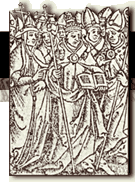

 |
 |
|||
|
|
||||
Readings for the Office |
||||
An office lectionary contains readings
for the office of Matins (also called Nocturns). Medieval Matins services
consisted of two or three nocturns (not to be confused with the other
name for Matins) that included recited lessons followed by sung responsories.
Matins on important feasts and Sundays had three nocturns, while less
important feasts and weekdays had only two nocturns. The lessons of the
first nocturn were drawn from the Bible, those of the second nocturn from
hagiographic or patristic texts, and those of the third nocturn from patristic
commentaries on scripture, often taken from a homiliary. The number of
lessons in each nocturn varied; on a weekday in winter or a minor feast,
a nocturn might contain only a single lesson. On a major feast or on a
Sunday, each nocturn would have 3 lessons (in cathedrals) or 4 lessons
(in monasteries). Lectionaries follow the order of feasts in the liturgical
year. Office lectionaries became less common after the development
of the breviary beginning in
the twelfth century. A legendary contains the lives of the saints celebrated in the liturgy. The book's name derives from the Latin legenda ("things to be read"). The legendary could be a source of the hagiographic texts recited in the second nocturn of Matins. Legendaries vary widely in their selection of saints and of texts. While their contents may vary, their order normally follows that of the liturgical year.
A homiliary contains homilies on the Gospel readings of the day; they
were the sermons delivered, often by the bishop, in late antiquity and
the early Middle Ages at mass. Excerpts from these texts were read in
the third nocturn of Matins.
|
|||||